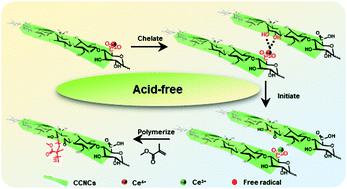当前位置:
X-MOL 学术
›
Green Chem.
›
论文详情
Our official English website, www.x-mol.net, welcomes your
feedback! (Note: you will need to create a separate account there.)
Polymer grafting on cellulose nanocrystals initiated by ceric ammonium nitrate: is it feasible under acid-free conditions?
Green Chemistry ( IF 9.3 ) Pub Date : 2021-09-30 , DOI: 10.1039/d1gc03142b
Yunxiao Liu 1, 2 , Yunjie Lu 1, 2 , Hui Zhang 1, 2 , Xinran Liu 1, 2 , Zhengqing Kong 1, 2 , Lijuan Zhou 1, 2 , Heng Liu 1, 2 , Jianming Zhang 1, 2
Green Chemistry ( IF 9.3 ) Pub Date : 2021-09-30 , DOI: 10.1039/d1gc03142b
Yunxiao Liu 1, 2 , Yunjie Lu 1, 2 , Hui Zhang 1, 2 , Xinran Liu 1, 2 , Zhengqing Kong 1, 2 , Lijuan Zhou 1, 2 , Heng Liu 1, 2 , Jianming Zhang 1, 2
Affiliation

|
It is of great significance to tailor the physicochemical properties of cellulose nanocrystals (CNCs) for broadening their application fields. Grafting polymerization initiated by cerium ammonium nitrate (CAN) in aqueous medium is a facile and efficient surface modification strategy for CNCs. However, CAN is generally used under strong acidic conditions to prevent hydrolysis; strong acids cause severe environmental problems and limit the monomer species of the candidate. Herein, an acid-free polymer grafting modification method initiated by CAN for carboxylated CNCs (CCNCs) was reported. For CCNCs, a high monomer conversion rate (>80%) and grafting yield (>200%) were obtained even at pH=7 when methyl methacrylate (MMA) was used as the monomer. It is worth noting that the time-consuming dialysis process for CNCs was not required before the grafting reaction, and the CNCs-g-PMMA can be “self-purified” due to its spontaneous precipitation from water. Moreover, the initiator's consumption in this system is very low (1.82 mmol L−1) compared with previously reported values. By investigating the interaction between CAN and CCNCs and the effect of CCNCs on the hydrolysis of CAN, it is revealed that a CCNC complex with Ce4+ acts as the “macromolecular initiator” to initiate the grafting polymerization under acid-free conditions. This work overcomes the limitation of strong acidic conditions for the polymer grafting modification of CNCs initiated by CAN and is conducive to the industrial production of polymer-grafted CNCs under environmentally friendly conditions.
中文翻译:

由硝酸铈铵引发的纤维素纳米晶体上的聚合物接枝:在无酸条件下是否可行?
调整纤维素纳米晶体(CNCs)的理化性质对于拓宽其应用领域具有重要意义。在水性介质中由硝酸铈铵 (CAN) 引发的接枝聚合是 CNC 的一种简便有效的表面改性策略。但CAN一般在强酸性条件下使用,以防止水解;强酸会导致严重的环境问题并限制候选单体的种类。在此,报道了一种由 CAN 引发的用于羧化 CNCs (CCNCs) 的无酸聚合物接枝改性方法。对于 CCNCs,当使用甲基丙烯酸甲酯 (MMA) 作为单体时,即使在 pH=7 的情况下也能获得高单体转化率 (>80%) 和接枝产率 (>200%)。g- PMMA 可以“自净化”,因为它会从水中自发沉淀。此外,与之前报道的值相比,该系统中引发剂的消耗量非常低(1.82 mmol L -1)。通过研究CAN和CCNCs之间的相互作用以及CCNCs对CAN水解的影响,揭示了CCNC与Ce 4+配合物作为“大分子引发剂”在无酸条件下引发接枝聚合。该工作克服了CAN引发的CNCs聚合物接枝改性强酸性条件的限制,有利于环境友好条件下聚合物接枝CNCs的工业化生产。
更新日期:2021-10-13
中文翻译:

由硝酸铈铵引发的纤维素纳米晶体上的聚合物接枝:在无酸条件下是否可行?
调整纤维素纳米晶体(CNCs)的理化性质对于拓宽其应用领域具有重要意义。在水性介质中由硝酸铈铵 (CAN) 引发的接枝聚合是 CNC 的一种简便有效的表面改性策略。但CAN一般在强酸性条件下使用,以防止水解;强酸会导致严重的环境问题并限制候选单体的种类。在此,报道了一种由 CAN 引发的用于羧化 CNCs (CCNCs) 的无酸聚合物接枝改性方法。对于 CCNCs,当使用甲基丙烯酸甲酯 (MMA) 作为单体时,即使在 pH=7 的情况下也能获得高单体转化率 (>80%) 和接枝产率 (>200%)。g- PMMA 可以“自净化”,因为它会从水中自发沉淀。此外,与之前报道的值相比,该系统中引发剂的消耗量非常低(1.82 mmol L -1)。通过研究CAN和CCNCs之间的相互作用以及CCNCs对CAN水解的影响,揭示了CCNC与Ce 4+配合物作为“大分子引发剂”在无酸条件下引发接枝聚合。该工作克服了CAN引发的CNCs聚合物接枝改性强酸性条件的限制,有利于环境友好条件下聚合物接枝CNCs的工业化生产。







































 京公网安备 11010802027423号
京公网安备 11010802027423号